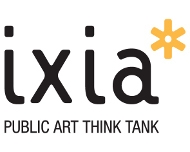ixia’s Public Art Survey 2011: Summary and Key Findings
Date uploaded: January 16, 2012
ixia’s Public Art Survey 2011: Summary
Public sector cutbacks and the wider economic downturn are fuelling a general pessimism in the public art sector, although there remains significant optimism amongst many of the more established artists.
Nearly 700 people participated in ixia’s Public Art Survey 2011. Of these, 500 work in the public art sector in the UK. However, our sample sizes for Scotland, Wales and Northern Ireland are too small to be confident in using the data, so the key findings concentrate on public art in England.
The survey is the first of its kind, and deals with a fragmented public art sector that can be difficult to define. The sector encompasses a variety of disciplines and organisations including: arts, planning, local authorities, development, regeneration, health and education. As a result, there are a wide range of work contexts that include: self-employed, which applies to the majority and comprises artists and public art consultants; full-time and part-time public art employees; full-time and part-time employees who have some involvement with public art; voluntary workers; and students.
Having correlated the survey’s sample with known population distributions, ixia’s databases and other data sources, we are able to make the following observations and estimates:
+ In England, during 2010-11, there was an active and core public art sector of at least 1,250 people in a market worth at least £56m;
+ The public art sector is largely driven by private sector money aligned to public sector policy. We estimate that 80% of public art funding can be linked to public art policies within local authorities and the regeneration, health and education sectors;
+ Many artists are optimistic about the future, but those workers closer to funding sources are much more pessimistic, predicting a fall of 40% in the overall size of the market during 2011-12;
+ We expect the recessionary trend in funding to continue in 2012-13 (and beyond), but there may be some amelioration as a result of public art projects linked to the Olympics;
+ In the long-term, a recovery in the development and regeneration sectors could drive growth in public art. This is dependent upon there being staff in place to implement planning policy structures for public art. We expect these policies to remain – in some form – in many local authorities. However, around 60% of local authority employees with responsibility for public art are either unsure about, or expecting to lose, their jobs;
+ Overall, the survey shows a predominantly female workforce: 64% female vs. 36% male. This breaks down as follows:
- For artists: 54% female vs. 46% male, with an older age profile for both females and males tending towards the 45 to 64 range;
- For consultants: 70% female vs. 30% male. The age range for females is evenly distributed between 25 to 44 (47.5%) and 45 to 65 (47.5%). For males, 66% are aged between 45 to 64;
- For salaried posts: 70% female vs. 30% male, with 67% of females aged between 25 to 44, and 62% of males aged between 45 to 64;
- The workforce is predominantly white (95%);
- 4% of respondents have a disability.
+ The cost of individual public art projects ranges from nothing to millions of pounds. The average cost of a public art project commissioned by a local authority, or via the regeneration, health and education sectors is approximately £73,000;
+ The most important role for public art is believed to be shaping national and regional identity. This is followed by improving the design of the environment, and then by performing an important social function.
To download key findings from the survey, please click here.(210 KB)

